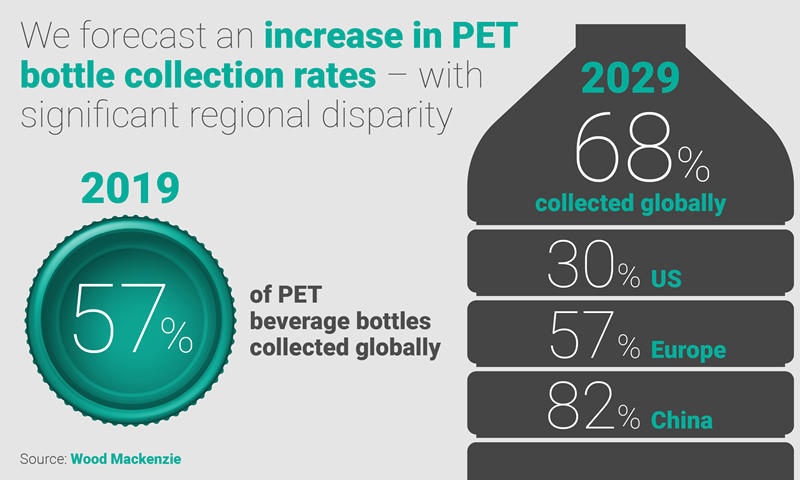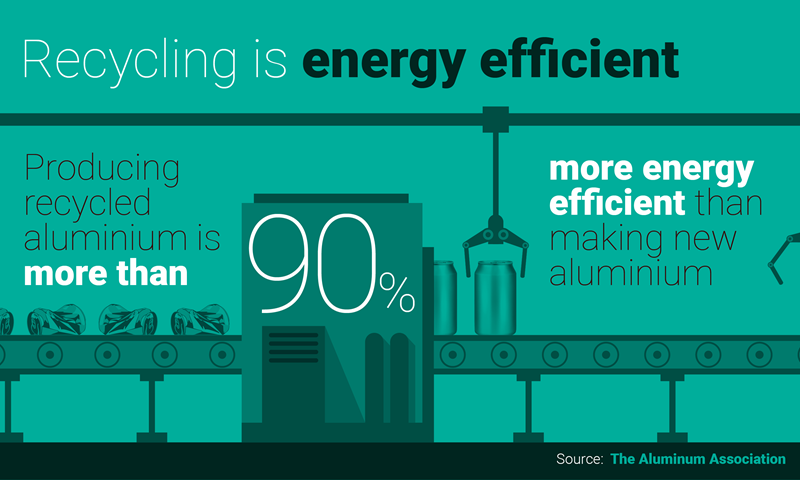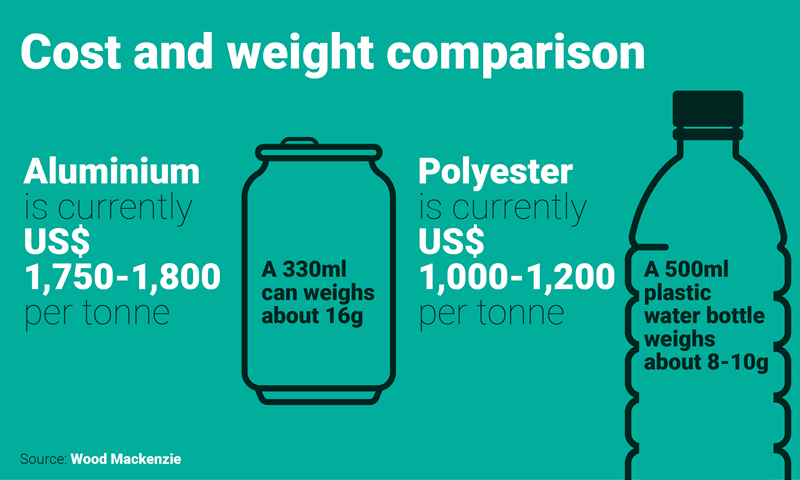Discuss your challenges with our solutions experts
1 minute read
Uday Patel
Senior Research Manager, Global Aluminium Markets

Uday Patel
Senior Research Manager, Global Aluminium Markets
Uday has over 30 years of experience in the metals & mining sector and is focused on global aluminium markets.
Latest articles by Uday
-
Opinion
Can America smelt again?
-
Opinion
How do Western sanctions on Russia impact the global metals, mining and coal markets?
-
Opinion
Aluminium: things to look for in 2024
-
Featured
Aluminium vs plastic: who’ll win the water bottle war?
Plastic pollution is a global problem. The statistics are alarming – and emotive. The WWF reports that 8 million tonnes of plastic are dumped in our oceans every year and 90% of seabirds have plastic in their stomachs.
However, it remains the modern world’s packaging material of choice. Roughly a third of the 350 Mt produced globally is used in packaging applications. But as public perception shifts and the issue gets pushed up the political agenda, the tide could be turning.
As the sustainability debate heightens, Uday Patel and Pieterjan Van Uytvanck explore one possible alternative.
The bottle battle
The humble single-use plastic water bottle has become a powerful symbol at the heart of the debate. Bottles used for beverages like water and soft drinks are typically made from polyethylene terephthalate (PET). And according to a European Commission study, PET bottles and their lids are some of the most commonly found items among ocean debris.
PET bottle consumption is increasing. As shown in our report on the EU’s single use plastic directive, in Europe it’s now around 140 units per person, per year. In the US it’s 290 units.
Globally, around 57% of these are collected, according to the latest figures from our RPET Global Supply Demand Analytics Service. Political pressure will see that figure rise. One of the most ambitious targets of the EU directive is the call for 90% of PET beverage bottles to be collected by 2029. Significant investment in new waste management infrastructure is needed to meet this goal.
But collection doesn’t guarantee recycling. In the US, 70% of the plastic collected for recycling goes to landfill. It’s 30% in the EU. Many argue that the real mission is to find a cleaner, greener alternative.
Aluminium is one contender. The Coca-Cola Company’s Dasani water brand, for example, will soon be available in cans in the US as part of its efforts to reduce plastic waste.
So how does a can compare to a plastic bottle?
The environmental impact of production
On a first-use basis, neither material scores highly.
Plastics rely on crude oil extraction. It’s an energy-intensive process, from drilling and refining to extrusion and moulding. A 2017 life cycle assessment study on PET resin from the CPME showed that producing virgin material requires 69.6 GJ/tonne.
Aluminium is extracted and refined from mined bauxite ore. It’s complicated, costly and energy-intensive. We calculate that it takes an average of 14,000 kWh of electricity to produce one tonne of aluminium. Life cycle assessment studies from the Aluminum Association indicate that the total primary demand for aluminium production is 138 GJ/tonne. Electrolysis accounts for the majority of the total primary energy requirements and it has also been shown that 36% (depending on location and value chain) of this energy demand can be sourced from renewable sources, often hydro.
In terms of temperatures, polymer can be produced and extruded at around 250-300°C. Aluminium smelting requires temperatures over 1,000 °C.
Recyclability: PET
PET has the highest recycling levels of any of the six most common resins used in packaging. By 2029 we forecast that 68% of PET bottles will be collected globally. There will be some disparity in regional collection rates, however: 30% in the US, 57% in Europe and 82% in China.
Some go into closed loop recycling, creating new food grade bottles. Others go into open loop recycling, destined for sheet or fibre applications. The environmental impact varies. Fibres that end up in duvet filling will probably stay out of landfill much longer than a poor quality “fast fashion” t-shirt.
In 2018, 19.7 million tonnes of food and beverage PET bottles were produced, with 845,000 tonnes mechanically recycled back into food and beverage bottles. By 2029 we predict that will reach 30.4 million tonnes, with more than 3 million tonnes mechanically recycled.
Demand for recycled PET (RPET) is growing. The EU directive includes a target to incorporate 25% of recycled content in all PET beverage bottles from 2025, increasing to 30% from 2030. Leading brands such as Coca-Cola, Danone and PepsiCo have all called for a 50% use of RPET in their bottles by 2030.
We forecast a six-fold increase in demand for RPET in Europe by 2030 as a result.
Recyclability: aluminium
Aluminium recycling is a true closed loop. According to the Aluminum Association, it’s one of the most recycled materials on the market. Recycling it saves more than 90% of the energy required to produce new metal.
Recycling rates for aluminium cans vary worldwide. In the UK, the recycling rate has reportedly risen to 75%, its highest ever level. In the US, a 2017 report showed the consumer recycling rate had seen a decline, to 49.4%. In Brazil, it’s more than 90%. In some countries rates are increased by income disparity, as the value of aluminium creates an economic impetus for collection.
Durability and flexibility
When it comes to durability, plastic bottles have an inherent advantage. While dented cans often end up on retailers’ discount shelves, plastic is less likely to deform in transit.
Flexibility is another advantage for PET. While supermarket shelves are stacked with resealable bottles of water in convenient different sizes, a two litre can of water is much less practical.
Shelf life
Shelf life is often defined more by contents than packaging, but it is a consideration. Drinks in cans generally have a longer shelf life than those in PET bottles.
Additives can improve the barrier properties of PET to extend shelf life, but there is often an environmental impact. Some are introduced in small enough quantities that recyclability is not affected. Others, such as colourants, mean the bottle cannot be recycled for food grade applications.
The food grade factor
Not all PET can be recycled back into new water bottles. Contamination, polymer degradation and additives can all affect suitability for food grade applications.
New technologies could help to resolve this. Chemical recycling shows promise as a way to upgrade lower-quality PET back into virgin-grade resin. This is a mid-term trend in our view, with significant volumes of chemically recycled material at least 5-10 years away. So, while 3 million tonnes of PET bottles will be mechanically recycled back into food and beverage bottles by 2029, the total will climb to 4.6 million tonnes with chemical recycling volumes.
In the case of aluminium, the recycling process itself has a sanitising effect.
Cost of materials
Aluminium is currently around US$1,750-1,800 per tonne. A 330ml can weighs around 16g.
The polyester for PET is around US$1,000-1,200 per tonne. A PET water bottle weighs about 8-10g and holds 500ml. However, as carbonated drinks need a stronger bottle the average weight will be around 22-25g for 500ml.
Plastic material does cost less and go further. On a per-litre basis a beverage will cost less to distribute, with less energy needed to transport it.
If the product is water, rather than a higher value beverage such as beer, the cost impact is amplified. Additional costs are typically pushed along the value chain to the customer. Price sensitive consumers may not tolerate the increase, so brand owners may be forced to absorb the additional cost.
Availability of stock
In the UK alone, 7.7 billion plastic water bottles are used each year. We estimate that replacing that with 7.7 billion cans would require 99,000 tonnes of additional aluminium sheet stock.
For some years, the aluminium rolling industry has been switching away from producing can stock to more profitable sheet for automotive applications. To trigger a reversal of that investment the conversion margin would need to shift. Rolling mills would have to be incentivised by a significant increase in the price of can stock.
Such a radical shift wouldn’t happen overnight. But regulation could drive a step change in polymer demand, with an impact on investment cycles as a result.
So, will aluminium cans replace plastic bottles?
Brands offering cans of water could find a receptive market, and it will be interesting to see how consumers respond over time. However, our data shows a trend decline in the consumption of aluminium beverage packaging over the next ten years, except for a few emerging markets in Southeast Asia.
Meanwhile, PET bottle consumption is increasing, at global level and in most regionals. Healthy living is one important driver. Put simply, people are choosing a bottle of water over a can of fizzy drink.
And the industry is changing. Targets are being set across the value chain to improve collection and recyclability and maintain more of a closed loop.
There’s a potential revival for the aluminium can market. But it’ll take three or four years to see if this is a real trend.
Uday Patel, quoted by Reuters, October 2019
Is there a better alternative to PET?
There’s no easy answer. Each “solution” has its own challenges. Paper or card options typically have a polymer coating that can be challenging to recycle. Glass is heavy, and inefficient to transport. Bioplastics have been criticised for diverting arable land from food crops, amongst other potential trade-offs to the environment. And will consumers pay for greener, but costlier alternatives for water on the go? Or will we all carry our own refillable water bottle in the future?
For a closer look at whether aluminium cans could get a new lease of life in future, look out for our report later this year.













